Did you know that some of the plants we always thought were native to Australia are actually from Southern Africa?
From Outback to Backyard: How to Design, Build and Maintain an Australian Native Garden
Creating a garden that not only enhances the aesthetic appeal of your home but also pays homage to local flora and the natural landscape is a rewarding endeavour. Australian native gardens, with their huge variety of striking plant species, offer an opportunity to do just this.
More than just a collection of plants, these gardens are a testament to the country’s unique biodiversity and rich history, as well as the passion of the people creating them.
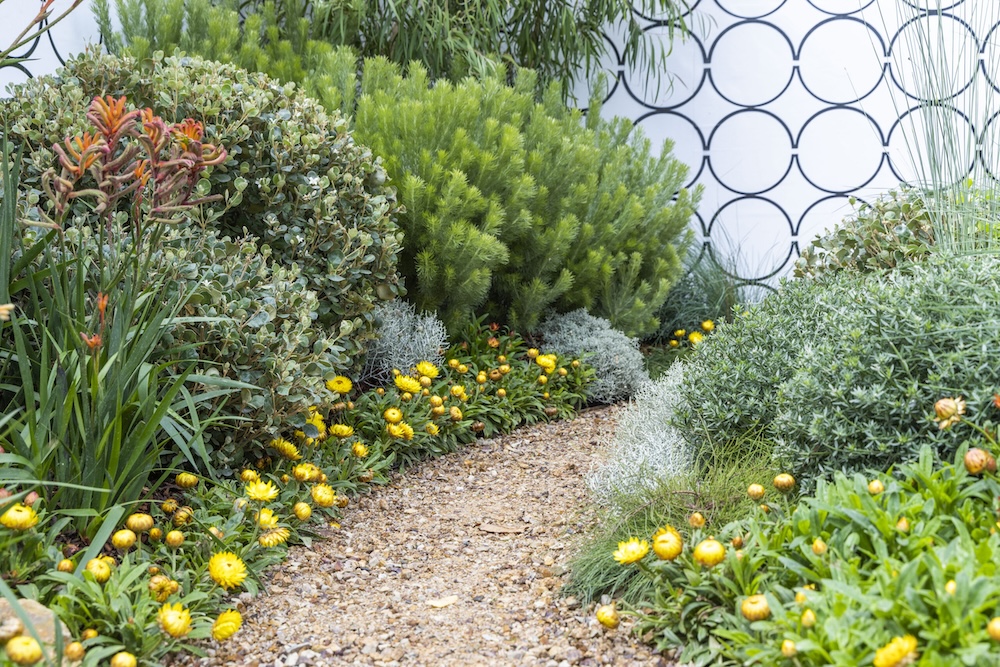
- Understanding Australian Native Landscape Garden Design
- Benefits of Australian Native Plants
- Assessing Your Site for Native Garden Design
- Choosing the Right Plants
- Designing Your Australian Native Garden
- Implementing Your Australian Native Garden Design
- Maintaining Your Australian Native Garden
- Daniel’s Wrap
Understanding Australian Native Landscape Garden Design
What is an Australian Native Garden?
An Australian native garden is a landscape design style that primarily features plants indigenous to Australia. These gardens are characterised by the diverse array of flora that thrive in Australia’s unique climates and soils, from the resilient native trees and shrubs of the arid outback to the lush ferns of the humid rainforests.
They’re often characterised as being “drought resistant” or “low-maintenance” with a scrub-like appearance, but that doesn’t have to be the case. Australia is a big place with a lot of different types of plants.
These gardens have a long-standing history in Australia. Indigenous Australians have been cultivating native plants for thousands of years, for food, medicine, and cultural practices.
With European settlement, exotic plants were introduced and became popular in gardening. However, a resurgence in the appreciation of native flora in the 20th century led to the popularisation of Australian native species in gardens.
In the 70s and 80s, we didn’t give our native plants the same level of care afforded to exotic plants, but that’s starting to change as gardeners and horticulturists are expecting their native plants to perform as well as their exotic counterparts
Benefits of Australian Native Plants
Australian native gardens offer a host of environmental, practical, and aesthetic benefits:
Environmental Benefits
Native gardens contribute significantly to local biodiversity by providing food sources and habitats for native wildlife. Food sources include pollen and nectar-rich flowers, seeds as well as soil organisms and “pests” that feed higher-level fauna such as birds and lizards.
Habitat can include thickets of stems and leaves as well as tree trunks and hollows that provide a safe place for all manner of insects and vertebrates to build their homes and hide from predators. Many native Aussie plants have evolved (and been bred) to have lower water and nutrient requirements, meaning that they are more environmentally sustainable.
Practical Benefits
An Australian native garden is often lower maintenance than a garden with exotic species, as native plants are typically better adapted to local soils and climate conditions, making them more durable and easier to care for.
However, it’s important to note that while many Australian native plants offer these benefits, it’s an over-generalisation to say all are better for biodiversity and lower maintenance than exotic alternatives.
The suitability and benefits of specific plants can vary greatly depending on local conditions and how they are cared for in the garden. Regardless, Australian native gardens are always a celebration of our native flora and hold a special place in the Australian psyche.
Aesthetic Benefits
Australian native gardens offer a unique aesthetic appeal that can transform any ordinary space into an enchanting oasis. Here are some key aesthetic benefits and considerations when designing an Australian native garden:
1. Variety and Versatility: Australia’s diverse ecosystems have resulted in a rich variety of plant species, each with its own unique beauty. From the vibrant colours of bottlebrushes and banksias to the delicate forms of grasses, trees and tree ferns, there’s a native plant to suit every garden style and personal aesthetic.
2. Seasonal Interest: Many Australian native plants bloom at different times of the year, providing an ever-changing display of colours and textures. For instance, wattles bloom in late winter to early spring, offering a burst of golden hues, after which billy buttons and kangaroo paws will put on a show until summer’s finished.
3. Texture and Form: Australian native plants offer a wealth of textures and forms to create visual interest and depth to garden designs. The intricate foliage of ferns, the sculptural forms of gymea lilies, or the weeping habit of certain eucalyptus species can all add dramatic elements to your garden design.
4. Sensory Experience: Native gardens engage more than just the visual senses. The rustling sound of gum leaves in the wind, the scent of Pandorea jasminoides flowers in bloom, or the tactile experience of a soft velvet kangaroo paw flower all contribute to a more immersive and engaging garden experience.
5. Connection to Place: Perhaps one of the most profound aesthetic benefits of an Australian native garden is the sense of connection it fosters. These gardens reflect the local landscape and climate, creating a sense of belonging and continuity with the surrounding natural environment.
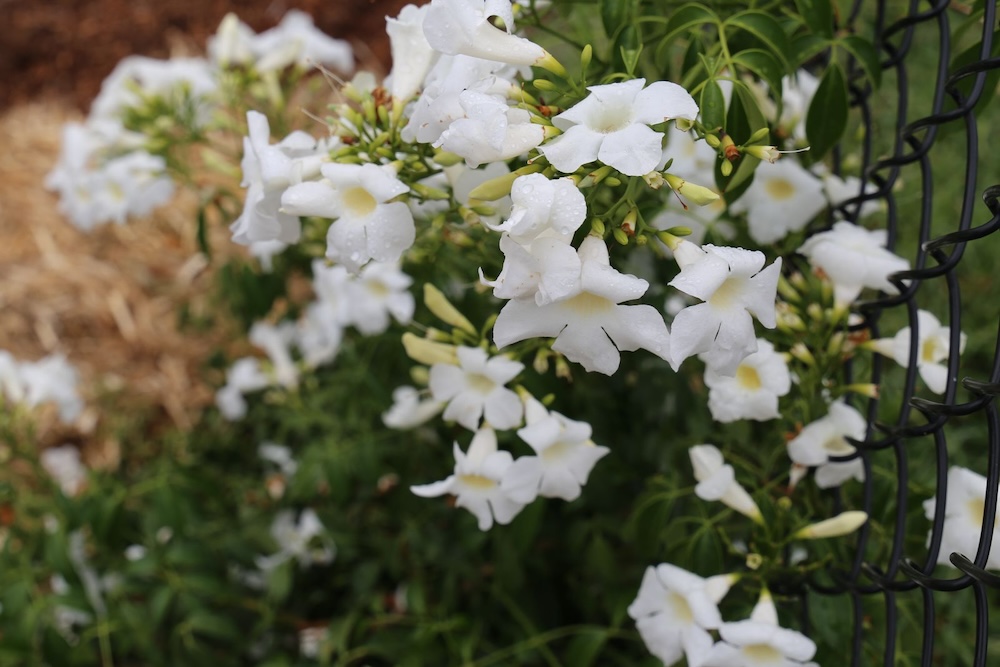
Assessing Your Site for Native Garden Design
Understanding your site’s conditions including soil type, climate, sunlight exposure, and other environmental factors is crucial for creating a thriving Australian native garden design.
Here are steps on how to conduct a basic site assessment:
1. Identify Your Climate Zone: Australia has a diverse range of climates, from tropical in the north to temperate in the south, Mediterranean to the west and arid in the centre. Identifying your climate zone will help determine which native plants are best suited to your area.
2. Assess Sunlight Exposure: Note the areas in your garden that receive full sun, partial shade, or full shade at different times throughout the day. Some native plants, like banksias, thrive in full sun, while others, like tree ferns, prefer shaded areas.
3. Test Your Soil: Soil type can significantly impact plant health. You can conduct a simple soil test to determine its pH level and a more thorough lab test to determine nutrient content.
Most Australian native plants prefer slightly acidic to neutral pH levels, but there are exceptions. Certain native plants, particularly Proteaceae members are sensitive to nutrient overload especially once they’ve become established in the environment.
4. Evaluate Moisture Capacity: Poorly drained soils can lead to root diseases. Check the drainage by digging a hole about 30cm deep, fill it with water, and see how long it takes to drain.
Compacted and heavy clays can be amended with gypsum. Meanwhile, sandy soils can become hydrophobic, meaning that the large soil particles become coated in plant waxes and there isn’t enough moisture to support the organisms that would break it down. Soil wetters can be used to immediately remedy the problem, and a quality hydrogel like Terracottem or a kaolin clay like Soil Solver can prevent issues in poor soil over the longer term.
5. Consider Wind Exposure: Some coastal native plants are adapted to withstand strong winds, while others may require more sheltered positions. Winds on the bay can be particularly harmful due to the salt carried from the ocean – plants like salt bush and westringia are able to tolerate this salt while others will struggle.
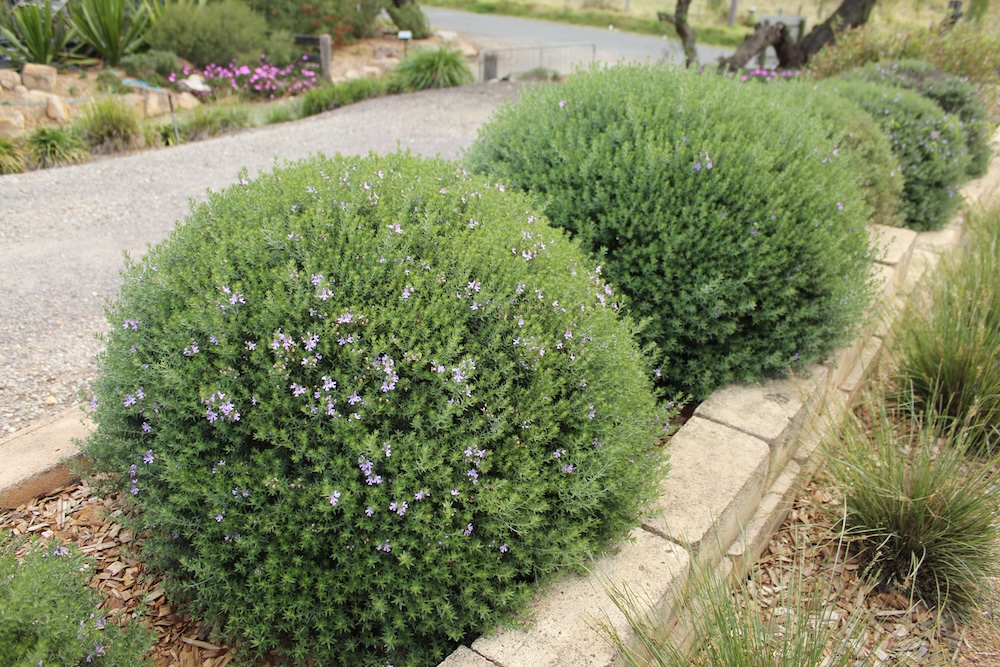
Choosing the Right Plants
Once you’ve assessed your site, the next step is selecting the right plants in terms of climate, growth habits, flower forms, and care requirements. Here are some tips for selecting plants according to site conditions and personal preferences:
1. Match Plants to Conditions: Choose plants that are naturally adapted to your site’s conditions. For instance, if your garden has sandy soil and full sun, consider sun-loving drought-tolerant natives like kangaroo paws (Anigozanthos spp.) or bottlebrush (Callistemon spp.).
2. Consider Size and Growth Habit: Be mindful of the mature size of plants to ensure they won’t outgrow their space. Also, consider their growth habit – whether they’re climbers, ground covers, shrubs, or trees – for layering and structuring your garden layout. Put short plants to the front and tall plants to the back to ensure they all get a chance to be admired and catch enough sunlight.
3. Seasonal Interest: Opt for a mix of shrubs and plants that provide year-round interest. This could be through flowers, foliage, bark, or seeds.
4. Wildlife Attraction: If attracting wildlife is a priority, select plants that provide food and habitat for local birds, insects, and other fauna.
5. Personal Preference: Lastly, choose plants and trees that you love. Whether it’s the vibrant blooms of a waratah (Telopea spp.) or the distinctive foliage of a wattle (Acacia spp.), your garden should reflect your personal taste and style.
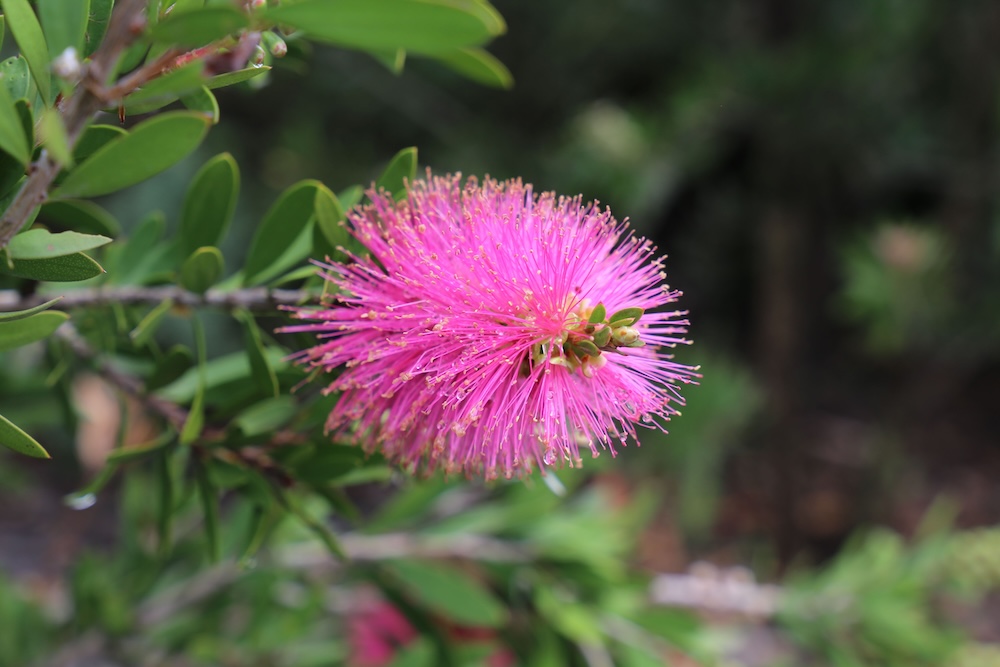
Designing Your Australian Native Garden
Designing an Australian native garden involves more than just choosing your favourite native plants. It’s about creating a balanced, harmonious outdoor space that showcases the natural beauty of Australia’s flora while serving your practical needs.
Basic Principles of Native Garden Design
Creating a well-designed Australian native garden requires an understanding of some basic design principles:
1. Unity and Harmony: Aim for a cohesive look by repeating certain elements (like plant types, shapes, or colours) throughout the whole garden. Incorporate a water feature to drown unwanted sounds, and screen out unwanted visuals such as next door’s window with trees or shrubs.
2. Balance: Achieve balance by considering the size, colour, and texture of different plants and how they relate to each other and the overall garden space.
3. Scale and Proportion: Ensure that all soft and hard landscape elements are in proportion with each other and the overall garden size. For example, a large gum tree may look out of place in a small courtyard garden.
4. Functional Elements: Don’t forget practical considerations like pathways, seating areas, and storage spaces. These should be integrated seamlessly into the design, using natural materials that complement the natural aesthetics of the native trees and plants.
Styles of Australian Native Gardens
Here are several design ideas for different garden styles and sizes:
1. Coastal Garden: For gardens near the coast, consider planting some hardy natives like coastal banksia (Banksia integrifolia), seaside daisy (Erigeron karvinskianus), native rosemary (Westringia spp.) and pigface (Carpobrotus glaucescens).
2. Dry Garden: In arid climates, opt for drought-tolerant species like spinifex (Spinifex sericeus), kangaroo paw (Anigozanthos spp.), and bottlebrush (Callistemon spp.).
3. Rainforest Garden: If you have a shaded, moist garden, create a lush rainforest feel with tree ferns (Dicksonia spp.), lilly pilly (Syzygium smithii), and native violets (Viola hederacea).
4. Small Urban Garden: Even in a small city garden, you can create a beautiful native garden haven with compact species like a columnar lilly pilly (Straight and Narrow™ Syzygium australe ‘SAN01’ [PBR Intended]), correas (Correa spp.), and native grasses like poas (Poa spp.).
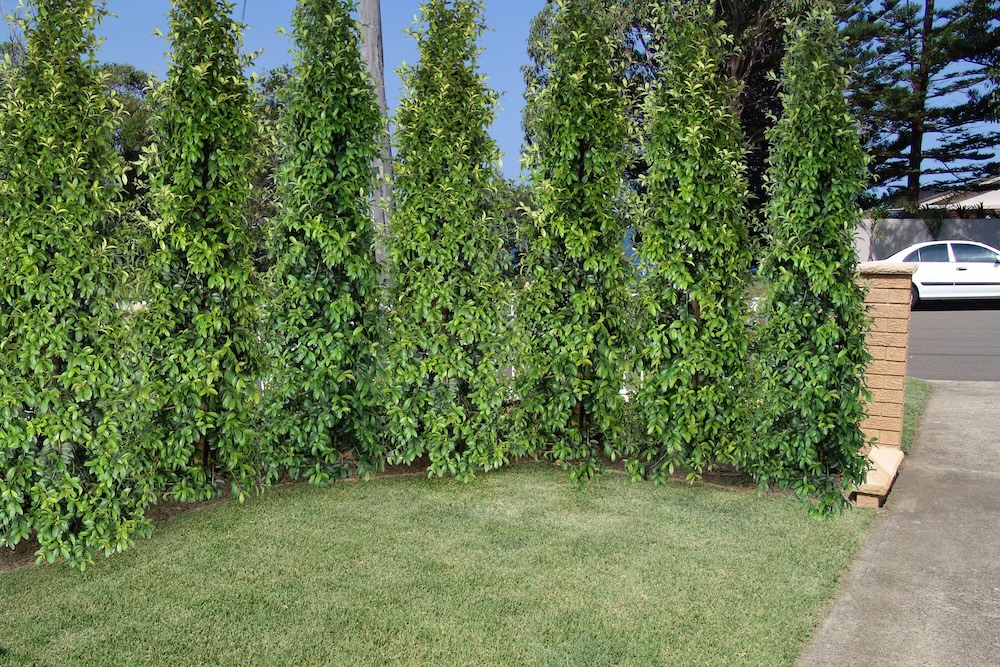
Implementing Your Australian Native Garden Design
Once you’ve finalised your design, it’s time to bring it to life.
Preparing the Site
Proper site preparation is key to ensuring your native plants thrive. Follow these steps:
1. Clear the Area: Remove any weeds, debris, or old plants that won’t be part of the new design.
2. Improve the Soil: Depending on your soil test results, you might need to amend the soil. For example, you can add compost or organic matter to improve fertility and drainage, gypsum to break apart clay, and hydrogels or kaolin clay to improve moisture retention in sand.
3. Set Up Irrigation: While many natives are drought-tolerant, they’ll still need water, especially when establishing and in the warmer months. Consider installing a drip irrigation system for efficient watering.
Planting Your Garden
Follow these steps to plant your Australian native garden:
1. Layout: Before you start digging, arrange your plants according to your design. This gives you a chance to make any last-minute adjustments.
2. Digging: Dig a hole twice as wide and just as deep as the root ball of each plant.
3. Planting: Place the plant in the hole, making sure the top of the root ball is level with the ground surface. Backfill the hole, firming the soil gently around the plant. (Remember, you need the right plant in the right place.)
4. Watering: Water the plants thoroughly after planting, and keep the soil moist until they’re established.
5. Mulching: Apply a 5-10cm layer of mulch around the plants to conserve moisture and suppress weeds. Opt for chunky mulch rather than fine mulch so that moisture can filter through to the root zone.
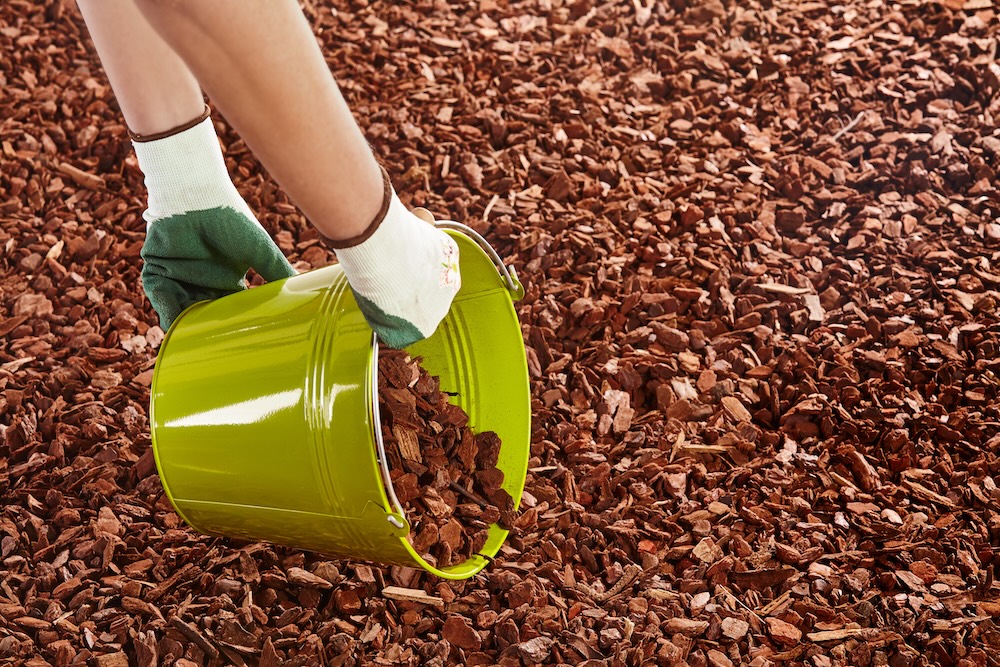
Maintaining Your Australian Native Garden
Creating an Australian native garden is a rewarding endeavour, but like all gardens, it requires ongoing care to keep it looking its best.
General Maintenance Tips
The maintenance requirements of your garden should be considered right from the design stage. Low-maintenance plants allow for more time to enjoy your garden and less spent on arduous tasks, while high-maintenance plants can provide a rewarding challenge for dedicated gardeners.
Here’s how to care for an Australian native garden:
1. Watering: While many Australian natives are drought-tolerant, they still need water, especially in their first few years. Water deeply but infrequently to encourage deep root growth. “Smart” irrigation systems take the hard work out of the process by leveraging technology.
2. Mulching: Re-apply chunky mulch every few years to help conserve soil moisture, suppress weeds, and maintain a consistent soil temperature. Warmer, wetter regions will require more frequent mulching, as the mulch breaks down more quickly.
3. Pruning: Regular pruning helps maintain the shape of your plants and encourages new growth. The best time to prune is often after flowering, depending on the particular type of plant.
Learn more about pruning through this link to another article I wrote.
4. Fertilising: Many Australian natives don’t need heavy fertilising. Proteaceae members like banksias and grevilleas in particular prefer very little phosphorous once established. However, most natives will do better with regular feeding just like their exotic distant cousins.
5. Pest and Disease Management: Monitor plants regularly for signs of pests or diseases. Early detection and intervention can prevent minor issues from becoming major problems.
Learn more about pest and disease management through this other article I wrote.
Dealing with Common Challenges
Despite your best efforts, you may encounter challenges like pests, diseases, or unfavourable weather conditions. Here’s how to handle these issues:
1. Pests: Some common pests include aphids, caterpillars, and borers. Use eco-friendly pest control methods like physical barriers, biological controls and white oil where possible.
2. Diseases: Fungal diseases can be a problem, especially in wet, humid conditions. Improve air circulation around plants, and avoid overhead watering to keep foliage dry. Make sure stems and leaves are in the air, while roots are in the ground and avoid mulching around the base of plants.
3. Weather Conditions: Protect plants from extreme weather conditions. Provide shade during heatwaves, cover during hail storms, and consider windbreaks in windy areas.
Daniel’s Wrap
Designing, implementing, and maintaining an Australian native garden is an exciting journey that brings the beauty of the Australian outback right into your backyard.
With careful planning, appropriate plant selection, and regular maintenance, you can create a stunning landscape that not only looks beautiful but also supports local biodiversity.
So why not start planning your Australian native garden project today? The rewards, both aesthetic and environmental, are well worth the effort.




This Post Has 0 Comments